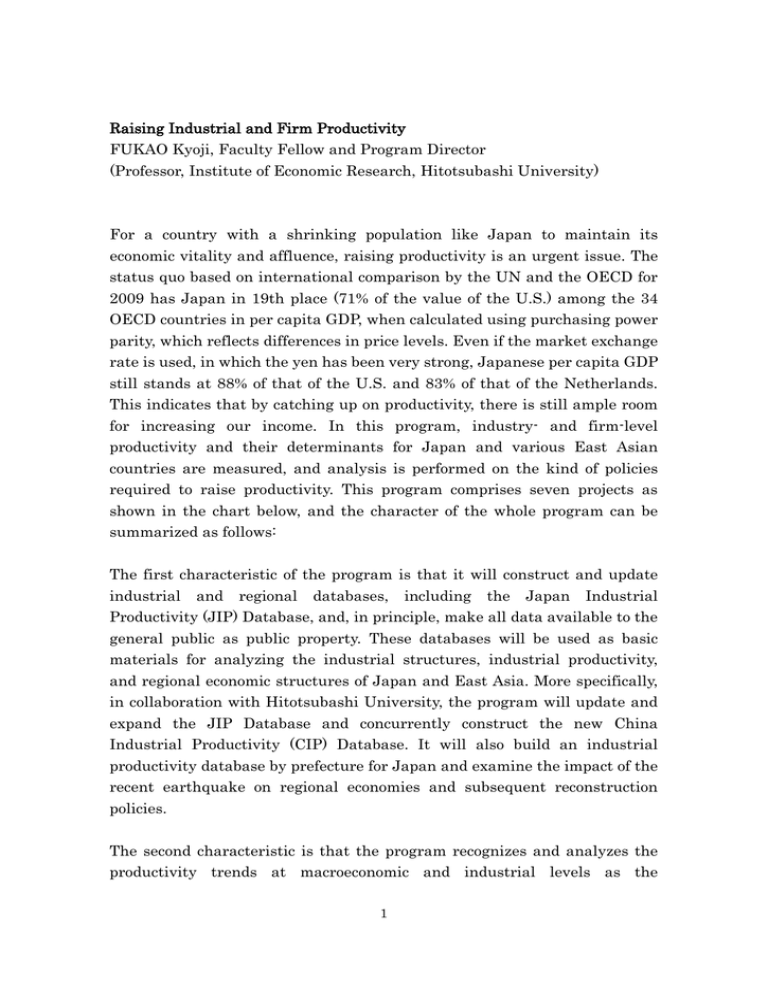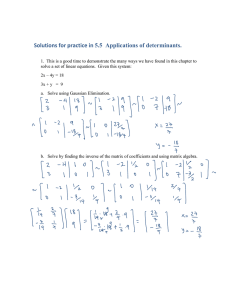Raising Industrial and Firm Productivity
advertisement

Raising Industrial and Firm Productivity FUKAO Kyoji, Faculty Fellow and Program Director (Professor, Institute of Economic Research, Hitotsubashi University) For a country with a shrinking population like Japan to maintain its economic vitality and affluence, raising productivity is an urgent issue. The status quo based on international comparison by the UN and the OECD for 2009 has Japan in 19th place (71% of the value of the U.S.) among the 34 OECD countries in per capita GDP, when calculated using purchasing power parity, which reflects differences in price levels. Even if the market exchange rate is used, in which the yen has been very strong, Japanese per capita GDP still stands at 88% of that of the U.S. and 83% of that of the Netherlands. This indicates that by catching up on productivity, there is still ample room for increasing our income. In this program, industry- and firm-level productivity and their determinants for Japan and various East Asian countries are measured, and analysis is performed on the kind of policies required to raise productivity. This program comprises seven projects as shown in the chart below, and the character of the whole program can be summarized as follows: The first characteristic of the program is that it will construct and update industrial and regional databases, including the Japan Industrial Productivity (JIP) Database, and, in principle, make all data available to the general public as public property. These databases will be used as basic materials for analyzing the industrial structures, industrial productivity, and regional economic structures of Japan and East Asia. More specifically, in collaboration with Hitotsubashi University, the program will update and expand the JIP Database and concurrently construct the new China Industrial Productivity (CIP) Database. It will also build an industrial productivity database by prefecture for Japan and examine the impact of the recent earthquake on regional economies and subsequent reconstruction policies. The second characteristic is that the program recognizes and analyzes the productivity trends at macroeconomic and industrial levels as the 1 aggregation of productivity trends of firms and plants that comprise the industry and the whole economy. By utilizing micro-data from government statistics and corporate financial data, this approach opens up a new research area on the determinants of productivity and will enable the provision of definite knowledge on policy effects. In particular, Japanese and Chinese micro-data from government statistics and corporate financial data will be used to study issues such as the determinants of productivity differentials between firms, the effects of globalization and changes in demand on corporate performance, policies for raising productivity in the service sector, and the comparison of productivity dynamics from an international perspective, including productivity differentials between Japanese, Chinese, and Korean firms. A firm-level database that measures and internationally compares total factor productivity of all listed firms of Japan, China, and Korea is planned to be constructed and made public. Additionally, at the industry and firm levels, the program will measure investment in intangible assets such as research and development, software, in-house training, and organizational change—all of which are important sources of innovation and growing productivity—and will examine the economic effects of such investments. The third characteristic of this program is that it will cooperate with overseas research projects and a range of both domestic and overseas research institutions and statistics organizations. Such cooperation will help make it possible to compare productivity and its determinants in Japan with those in other countries. At the same time, it will contribute to improvements in government statistics, the statistics of international institutions, and to domestic and overseas research on productivity. More specifically, the global collaborations that are planned are as follows: First, by cooperating with the Asian Development Bank Institute (ADBI), National University of Singapore, Harvard University, and University of Groningen, the program aims to push ahead with the construction of the Asia KLEMS Network, which measures the industrial structure and productivity of various Asian countries and compares them with other regions of the world. Second, the program will continue to provide data on Japan’s industrial structure and productivity to the EU’s World Input-Output Database (WIOD) project, World KLEMS project, the OECD, etc. Third, the program 2 will cooperate with researchers of the Economic and Social Research Institute (ESRI) of the Cabinet Office of Japan on the construction of a productivity database directly linked with System of National Accounts (SNA) statistics and the development of methods for measuring the output of non-market services such as health care and education. Fourth, together with researchers of the National Institute of Science and Technology Policy (NISTEP) of the Ministry of Education, Culture, Sports, Science and Technology (MEXT), the program will conduct studies on the sources and effects of innovation. Finally, the program will conduct research in collaboration with researchers from the OECD, Imperial College London, Seoul National University, and other institutions on the international comparison on investment in intangible assets, and with researchers from Peking University, Sogang University, and other institutions on the international comparison of productivity levels of firms. Additionally, for the international comparison of productivity levels, we have won the cooperation of the International Comparison Program (ICP), led by the World Bank, for purchasing power parity data. 3






